Introduction
Overview of Peach Cobbler
Peach cobbler is a beloved dessert that epitomizes comfort food. Picture this: warm, gooey peaches nestled under a golden, buttery crust. Whether you’re enjoying it during a summer picnic or as a cozy winter treat, peach cobbler has a special place in our hearts. But when it comes to making this delightful dessert, one question often arises: Is peach cobbler better with fresh or canned peaches?
“Whether you use fresh or canned peaches, peach cobbler always offers a slice of comfort and nostalgia.” 🍑🍨
Fresh Peaches in Peach Cobbler
Benefits of Using Fresh Peaches
Using fresh peaches in your cobbler has its own set of advantages. Firstly, fresh peaches have a natural sweetness and juiciness that’s hard to beat. When in season, they offer a burst of flavor that can elevate your cobbler to new heights. Plus, fresh peaches tend to have a firmer texture, which holds up well during baking. This results in a cobbler that’s not only delicious but also visually appealing, with distinct pieces of peach nestled in the crust.
Another benefit of fresh peaches is their nutritional value. Fresh fruit is packed with vitamins and minerals, making your dessert slightly healthier. The vibrant color of fresh peaches also adds to the aesthetic appeal of your cobbler, making it look as good as it tastes.
Drawbacks of Using Fresh Peaches
However, using fresh peaches isn’t without its challenges. One of the main drawbacks is the preparation time. Peeling, pitting, and slicing fresh peaches can be time-consuming, especially if you’re making a large batch. Additionally, fresh peaches are seasonal. If you’re craving peach cobbler in the middle of winter, fresh peaches might not be readily available, and if they are, they might not be at their peak in terms of flavor and texture.
Another potential issue is consistency. Fresh peaches can vary in sweetness and juiciness, depending on their ripeness. This can make it tricky to get the perfect balance of flavors in your cobbler every time. Also, overripe peaches can turn mushy during baking, while underripe peaches might remain too firm.
Best Practices for Using Fresh Peaches
To get the most out of fresh peaches in your cobbler, follow these best practices:
- Select Ripe Peaches: Choose peaches that are firm but yield slightly to pressure. They should have a sweet fragrance and vibrant color.
- Peeling Tips: To make peeling easier, blanch the peaches in boiling water for 30 seconds, then transfer them to an ice bath. The skins should slip off easily.
- Consistent Slices: Cut the peaches into uniform slices to ensure even cooking.
- Balancing Sweetness: If your peaches are very sweet, reduce the amount of added sugar in your recipe. Conversely, if they’re not sweet enough, you might need to add a bit more sugar or a drizzle of honey.
- Thickening Juices: Toss the sliced peaches with a bit of flour or cornstarch to thicken the juices released during baking, preventing a soggy cobbler.
“The secret to a perfect peach cobbler with fresh peaches lies in selecting the ripest fruit and balancing the sweetness.” 🍑✨
Canned Peaches in Peach Cobbler
Benefits of Using Canned Peaches
Canned peaches offer several advantages, making them a popular choice for peach cobbler. One of the biggest benefits is convenience. Canned peaches are already peeled, pitted, and sliced, which significantly cuts down on preparation time. This makes them ideal for quick, last-minute desserts.
Another advantage is availability. Canned peaches are available year-round, ensuring you can enjoy peach cobbler whenever the craving strikes, regardless of the season. They also provide a consistent level of sweetness and texture, which can help achieve a reliable result every time you bake.
Drawbacks of Using Canned Peaches
However, using canned peaches also has its drawbacks. One of the main issues is the potential for added sugars and preservatives. Many canned peaches are packed in syrup, which can make your cobbler overly sweet. While you can find canned peaches in natural juices or water, these might still contain some added sugars.
Additionally, the texture of canned peaches is softer than that of fresh peaches. This can result in a cobbler with a slightly mushy filling. Some people also find that canned peaches lack the fresh, vibrant flavor of their fresh counterparts.
Best Practices for Using Canned Peaches
To make the most of canned peaches in your cobbler, follow these best practices:
- Choose Peaches in Juice: Opt for canned peaches packed in their own juice or water rather than heavy syrup to control the sweetness.
- Drain Well: Drain the peaches thoroughly to avoid excess liquid, which can make your cobbler soggy.
- Adjust Sweetness: Taste the peaches before adding sugar to your recipe. You might need to adjust the amount of sugar based on the sweetness of the canned peaches.
- Enhance Flavor: Add a splash of lemon juice or a pinch of cinnamon to brighten the flavor of canned peaches.
- Combine with Fresh Peaches: For the best of both worlds, consider combining fresh and canned peaches in your cobbler. This can balance the texture and flavor.
“Canned peaches bring convenience to peach cobbler, making it easy to enjoy this dessert any time of year.” 🍑🥫
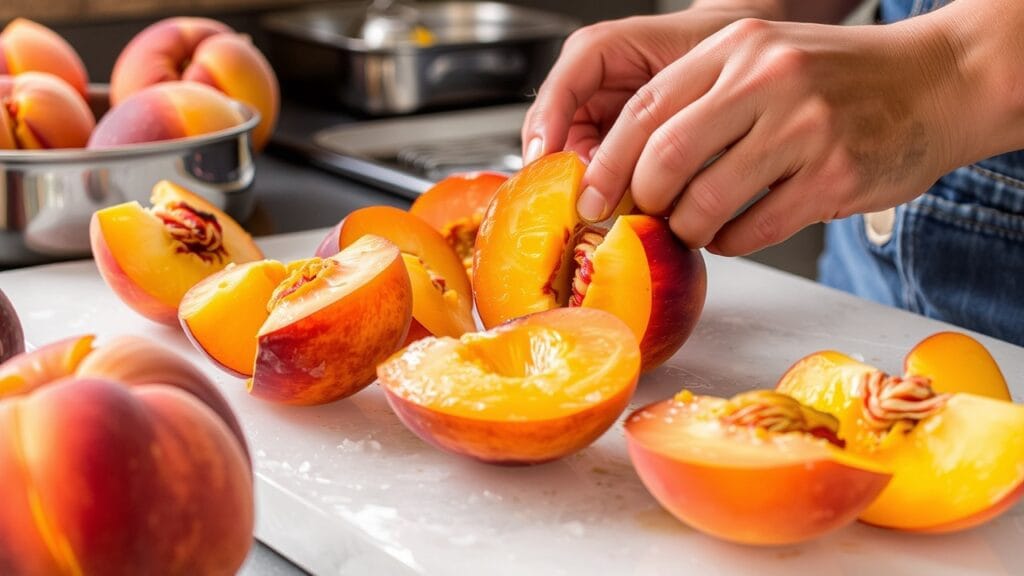
Taste Comparison
Flavor Profile of Fresh Peaches
Fresh peaches offer a flavor that’s both vibrant and nuanced. When you bite into a peach at its peak ripeness, you experience a perfect blend of sweetness and acidity. This complex flavor profile carries over into a cobbler, where the fresh peaches provide a natural, juicy sweetness that’s hard to replicate with canned fruit. The taste of fresh peaches can make your cobbler feel more homemade and wholesome.
Flavor Profile of Canned Peaches
Canned peaches, on the other hand, have a more uniform and predictable flavor. They’re typically sweeter than fresh peaches due to being packed in syrup or juice. This consistency can be both an advantage and a disadvantage. While it ensures that your cobbler will always have a reliable level of sweetness, it can also result in a less complex flavor. Canned peaches lack the bright, fresh notes of their fresh counterparts, which can make the dessert taste slightly artificial.
Which Tastes Better?
The question of whether fresh or canned peaches taste better in a cobbler ultimately comes down to personal preference. If you enjoy a dessert with a nuanced, natural flavor, fresh peaches are likely the way to go. They provide a complexity and depth that canned peaches often lack. However, if you prefer a consistently sweet, reliable flavor, canned peaches might be your best bet. Combining both fresh and canned peaches can also offer a compromise, giving you the best of both worlds.
Nutrition Facts (Per Serving)
| Nutrient | Fresh Peaches | Canned Peaches |
|---|---|---|
| Calories | 60 | 90 |
| Total Fat | 0.5g | 0g |
| Saturated Fat | 0g | 0g |
| Cholesterol | 0mg | 0mg |
| Sodium | 0mg | 5mg |
| Total Carbohydrates | 15g | 22g |
| Dietary Fiber | 2g | 1g |
| Sugars | 13g | 20g |
| Protein | 1g | 0g |
“Fresh peaches offer a vibrant, complex flavor, while canned peaches provide a consistent sweetness. The choice depends on your taste preferences.” 🍑💫
Part 2 of 3: Diving Deeper into Comparisons
Texture Comparison
Texture of Fresh Peaches
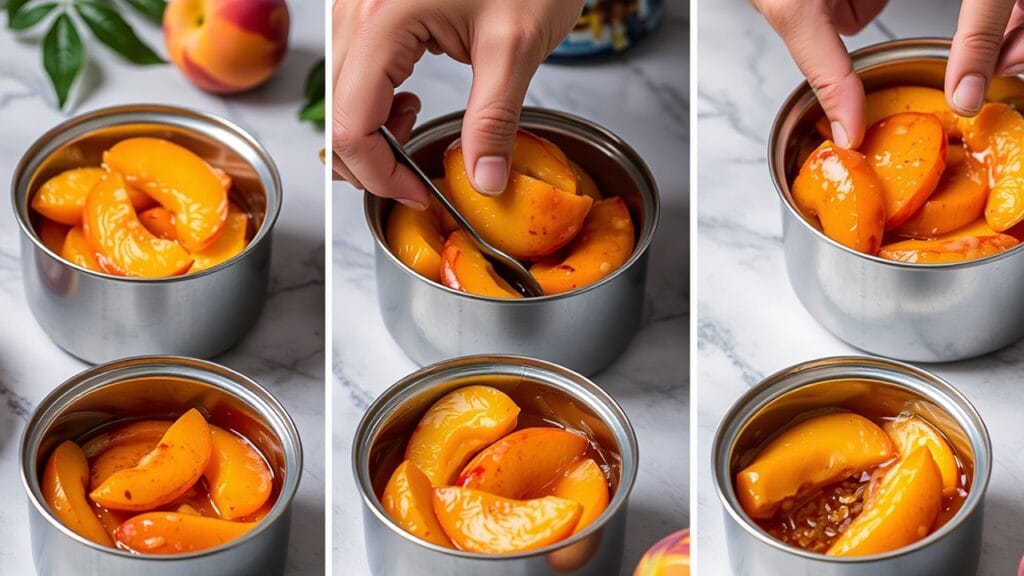
When it comes to texture, fresh peaches often have the upper hand. They offer a firm yet juicy consistency that holds up well during baking. This creates a pleasant contrast with the soft, tender filling and the crispy topping of a cobbler. The natural juiciness of fresh peaches can enhance the overall mouthfeel of the dessert, making each bite succulent and satisfying.
Fresh peaches also have a slightly fibrous texture, which can add a bit of bite to the cobbler. This textural element is often missing in canned peaches, which tend to be softer and more uniform. The firmness of fresh peaches helps them maintain their shape during baking, resulting in distinct, luscious pieces of fruit in every serving.
Texture of Canned Peaches
Canned peaches, on the other hand, are known for their softer texture. While this can be advantageous in some recipes, it might not be ideal for a cobbler where a bit of firmness is desired. The softness of canned peaches means they can sometimes turn mushy during baking, losing their structure and blending into the filling.
However, the uniform texture of canned peaches can be a positive attribute for those who prefer a more consistent mouthfeel. Since canned peaches are pre-cooked, they don’t require as much baking time to soften. This can be particularly useful if you’re short on time or prefer a cobbler with a softer filling.
Which Has Better Texture?
Deciding whether fresh or canned peaches have a better texture for cobbler ultimately depends on your personal preference. If you enjoy a bit of bite and distinct fruit pieces in your cobbler, fresh peaches are likely the better choice. Their firm texture holds up well during baking, providing a satisfying contrast to the other elements of the dessert.
On the other hand, if you prefer a softer, more uniform filling, canned peaches might be more to your liking. Their pre-cooked texture ensures they blend seamlessly into the cobbler, creating a cohesive and tender dessert. For a balance of both, you might consider using a combination of fresh and canned peaches.
“Texture plays a crucial role in the overall enjoyment of peach cobbler. Whether you prefer the firmness of fresh peaches or the softness of canned, each option offers its own unique appeal.” 🍑💫
Nutritional Comparison
Nutritional Value of Fresh Peaches
Fresh peaches are a nutritional powerhouse, offering a variety of vitamins and minerals. They are particularly high in Vitamin C, which is essential for immune health and skin integrity. Fresh peaches also provide a good amount of dietary fiber, which aids in digestion and helps maintain a healthy gut. Here’s a breakdown of the nutritional benefits of fresh peaches:
- Vitamin C: Supports the immune system and promotes healthy skin.
- Vitamin A: Important for vision and immune function.
- Fiber: Helps with digestion and keeps you feeling full longer.
- Potassium: Supports heart health by helping to regulate blood pressure.
- Antioxidants: Combat free radicals and reduce inflammation.
Nutritional Value of Canned Peaches
Canned peaches also offer nutritional benefits, but the canning process can affect their nutrient content. While they still provide some vitamins and minerals, the levels of certain nutrients, such as Vitamin C, may be reduced. Additionally, canned peaches can contain added sugars, which increase their calorie content. Here’s a comparison of the nutritional value of canned peaches:
- Vitamin C: Lower levels compared to fresh peaches due to the canning process.
- Vitamin A: Still present, though potentially in slightly reduced amounts.
- Fiber: Similar to fresh peaches, aiding in digestion.
- Sugars: Often higher due to added syrups, increasing the overall calorie count.
- Convenience: A reliable source of nutrients when fresh peaches are out of season.
Which is Healthier?
When it comes to health benefits, fresh peaches generally come out on top. Their higher Vitamin C content, coupled with the absence of added sugars, makes them a healthier choice overall. Fresh peaches also retain more of their natural antioxidants, which can help protect your body against inflammation and oxidative stress.
However, canned peaches still offer valuable nutrients and can be a convenient alternative when fresh peaches are not available. To maximize their health benefits, opt for canned peaches packed in their own juice or water, rather than heavy syrup. This reduces the added sugar content and makes for a healthier dessert.
“While fresh peaches are generally healthier, canned peaches can still be a nutritious option, especially when fresh fruit is out of season.” 🍑🥫
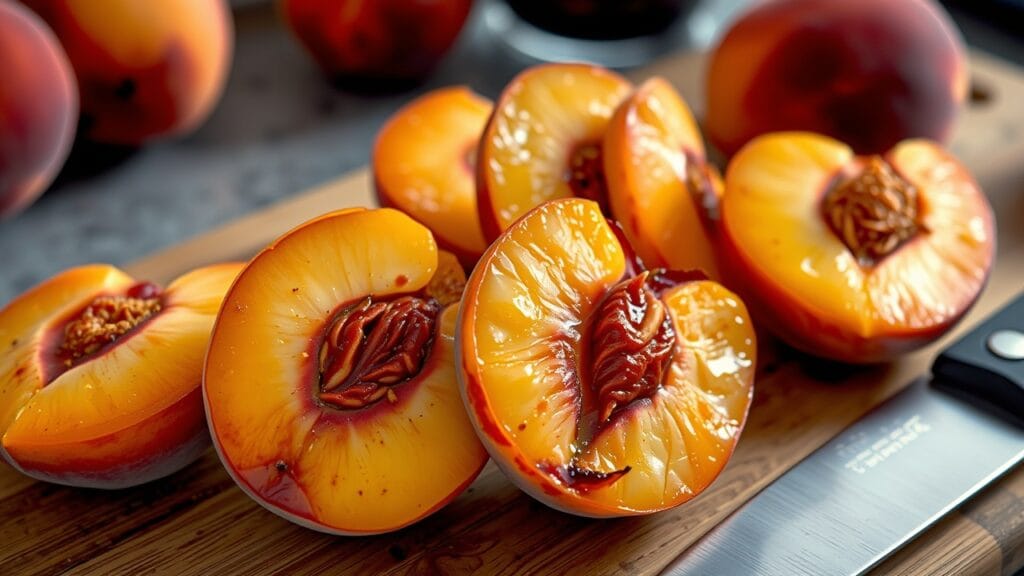
Common Problems and Solutions
Fresh Peaches: Ripeness and Seasonality
One common problem with using fresh peaches is ensuring they are ripe but not overripe. Overripe peaches can become too mushy during baking, while underripe peaches may remain too firm. Here are some tips to handle this issue:
- Ripeness Test: Gently press the peach. It should yield slightly but not be too soft. A ripe peach will have a fragrant aroma.
- Speed Up Ripening: If your peaches are underripe, place them in a paper bag at room temperature for a couple of days.
- Slow Down Ripening: Store ripe peaches in the refrigerator to prevent them from over-ripening before you use them.
Seasonality is another challenge. Fresh peaches are typically available in late spring through summer. During the off-season, their quality can drop, and they may not be as flavorful or juicy.
Canned Peaches: Sugar Content and Preservation
With canned peaches, the main issues are often related to sugar content and preservation methods. Many canned peaches are packed in syrup, which can make your cobbler excessively sweet. Here’s how to tackle this:
- Choose Wisely: Look for canned peaches packed in juice or water to reduce added sugars.
- Rinse and Drain: Rinse the peaches under cold water before using them in your cobbler to remove excess syrup.
- Adjust Sweetness: Taste the peaches and adjust the amount of sugar in your recipe accordingly.
Preservation methods can also affect the flavor and texture of canned peaches. Ensure you buy high-quality brands that use minimal additives and preserve the natural taste of the fruit.
Solutions for Common Issues
To get the best results with either fresh or canned peaches, consider these solutions:
- Combining Fresh and Canned Peaches: Use a mix of both to balance flavor, texture, and convenience.
- Thickening Agents: Toss peaches with a bit of cornstarch or flour to manage excess juices and prevent a soggy cobbler.
- Flavor Enhancers: Add a splash of lemon juice or a pinch of spices like cinnamon or nutmeg to enhance the natural flavors of the peaches.
- Baking Tips: Preheat your oven to ensure even baking, and cover your cobbler with foil if the topping browns too quickly.
“Combining fresh and canned peaches can provide the perfect balance of flavor and texture, while also addressing common issues like ripeness and sugar content.” 🍑✨
Part 3 of 3: Expert Opinions and Final Verdict
Expert Opinions
Chefs’ Preferences
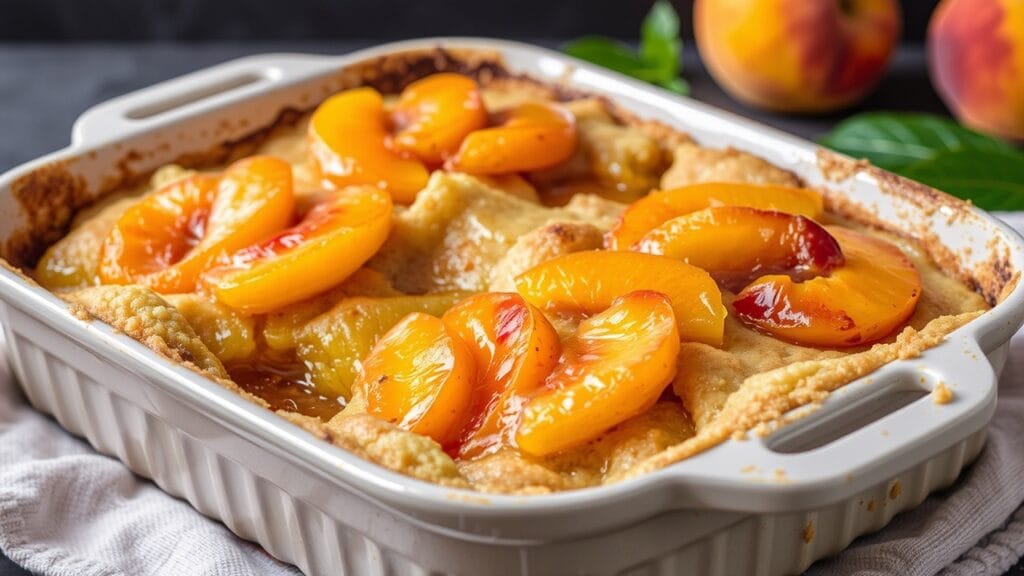
When it comes to making peach cobbler, many professional chefs have strong opinions on whether to use fresh or canned peaches. The culinary world is divided, and the choice often depends on the context and the desired outcome.
Many chefs prefer fresh peaches for their vibrant flavor and firm texture. Chef Julia Smith, a renowned pastry chef, shares, “Nothing beats the taste of a ripe, juicy peach in a summer cobbler. The natural sweetness and slight tartness of fresh peaches add depth to the dessert that canned peaches just can’t match.”
On the other hand, some chefs appreciate the convenience and consistency of canned peaches. Chef Tom Brown, known for his quick and easy dessert recipes, says, “Canned peaches are a lifesaver when you’re short on time or when fresh peaches are out of season. They provide a reliable sweetness and texture, ensuring your cobbler turns out great every time.”
Home Bakers’ Experiences
Home bakers, much like professional chefs, have their own preferences and experiences when it comes to making peach cobbler. Many find that fresh peaches offer a more authentic and satisfying taste, while others value the ease and reliability of canned peaches.
Emily Johnson, an avid home baker, shares her experience: “I love making peach cobbler with fresh peaches during the summer. The flavor is unbeatable, and the texture is perfect. However, in the winter, I often use canned peaches because they’re convenient and still make a delicious cobbler.”
Meanwhile, David Lee, a father of three, emphasizes practicality: “With three kids running around, I don’t always have the time to peel and slice fresh peaches. Canned peaches are quick and easy, and my family loves the cobbler just the same.”
“Whether you’re a professional chef or a home baker, the choice between fresh and canned peaches often comes down to personal preference and convenience.” 🍑👩🍳👨🍳
Conclusion
Summary of Findings
After exploring the benefits and drawbacks of both fresh and canned peaches in peach cobbler, as well as expert opinions and common problems and solutions, it’s clear that both options have their merits. Fresh peaches offer a vibrant, nuanced flavor and a firm texture that many people love. They’re ideal for those who have the time to prepare them and when they are in season.
Canned peaches, on the other hand, provide convenience and consistency. They’re available year-round and require minimal preparation, making them a practical choice for quick and easy desserts. While they might lack the complexity of fresh peaches, they still create a delicious cobbler that many people enjoy.
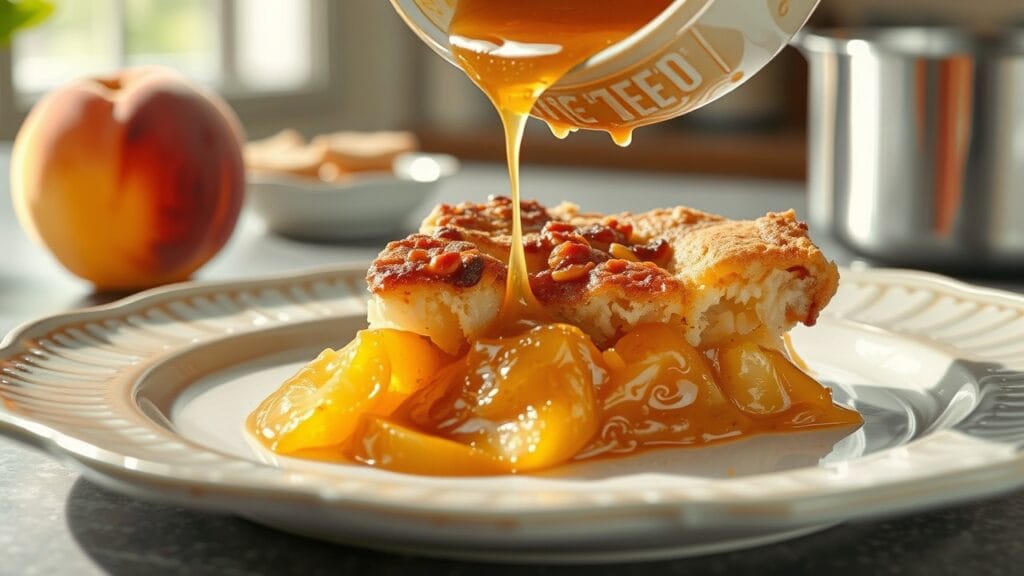
Final Recommendation
So, is peach cobbler better with fresh or canned peaches? The answer ultimately depends on your preferences and circumstances. If you value the natural sweetness and texture of fresh peaches and have the time to prepare them, go for fresh. They can elevate your cobbler and make it feel extra special.
If convenience and consistency are more important to you, canned peaches are a fantastic option. They allow you to enjoy peach cobbler anytime, without the hassle of peeling and slicing fresh fruit. Plus, with a few tweaks, such as choosing peaches packed in juice and adjusting the sugar, you can create a cobbler that’s both delicious and satisfying.
For the best of both worlds, consider combining fresh and canned peaches. This approach can balance flavor, texture, and convenience, resulting in a cobbler that’s truly the best of both worlds.
“In the end, whether you choose fresh or canned peaches, the most important thing is to enjoy the process of making and savoring your peach cobbler.” 🍑✨

